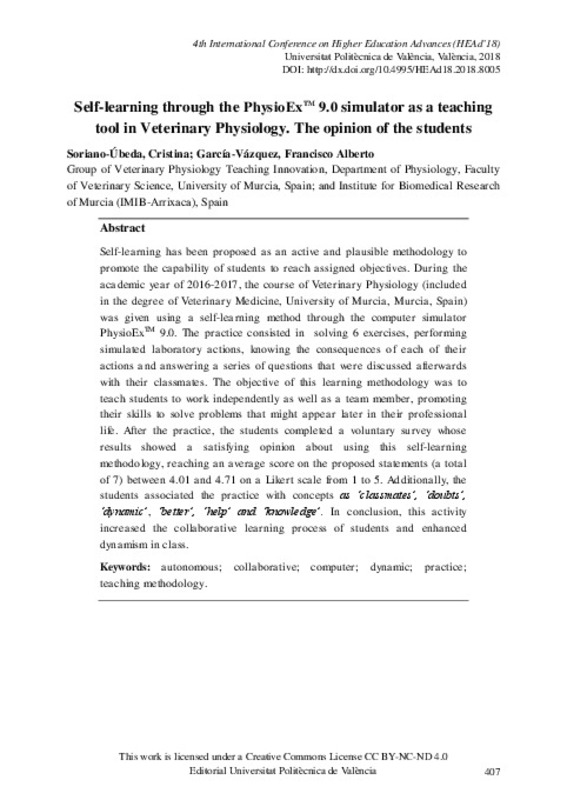JavaScript is disabled for your browser. Some features of this site may not work without it.
Buscar en RiuNet
Listar
Mi cuenta
Estadísticas
Ayuda RiuNet
Admin. UPV
Self-learning through the PhysioExTM 9.0 simulator as a teaching tool in Veterinary Physiology. The opinion of the students
Mostrar el registro sencillo del ítem
Ficheros en el ítem
| dc.contributor.author | Soriano Úbeda, Cristina
|
es_ES |
| dc.contributor.author | García Vázquez, Francisco
|
es_ES |
| dc.date.accessioned | 2018-10-05T13:25:28Z | |
| dc.date.available | 2018-10-05T13:25:28Z | |
| dc.date.issued | 2018-10-05T13:25:28Z | |
| dc.identifier.isbn | 9788490486900 | es_ES |
| dc.identifier.issn | 2603-5871 | |
| dc.identifier.uri | http://hdl.handle.net/10251/109702 | |
| dc.description.abstract | [EN] Self-learning has been proposed as an active and plausible methodology to promote the capability of students to reach assigned objectives. During the academic year of 2016-2017, the course of Veterinary Physiology (included in the degree of Veterinary Medicine, University of Murcia, Murcia, Spain) was given using a self-learning method through the computer simulator PhysioExTM 9.0. The practice consisted in solving 6 exercises, performing simulated laboratory actions, knowing the consequences of each of their actions and answering a series of questions that were discussed afterwards with their classmates. The objective of this learning methodology was to teach students to work independently as well as a team member, promoting their skills to solve problems that might appear later in their professional life. After the practice, the students completed a voluntary survey whose results showed a satisfying opinion about using this self-learning methodology, reaching an average score on the proposed statements (a total of 7) between 4.01 and 4.71 on a Likert scale from 1 to 5. Additionally, the students associated the practice with concepts as ‘classmates’, ‘doubts’, ‘dynamic’, ‘better’, ‘help’ and ‘knowledge’. In conclusion, this activity increased the collaborative learning process of students and enhanced dynamism in class. | es_ES |
| dc.description.uri | http://ocs.editorial.upv.es/index.php/HEAD/HEAD18 | es_ES |
| dc.format.extent | 8 | |
| dc.language | Inglés | es_ES |
| dc.publisher | Editorial Universitat Politècnica de València | es_ES |
| dc.relation.ispartof | 4th International Conference on Higher Education Advances (HEAD'18) | |
| dc.rights | Reconocimiento - No comercial - Sin obra derivada (by-nc-nd) | es_ES |
| dc.subject | Higher Education | es_ES |
| dc.subject | Learning | es_ES |
| dc.subject | Educational systems | es_ES |
| dc.subject | Teaching | es_ES |
| dc.subject | Autonomous | |
| dc.subject | Collaborative | |
| dc.subject | Computer | |
| dc.subject | Dynamic | |
| dc.subject | Practice | |
| dc.subject | Teaching methodology | |
| dc.title | Self-learning through the PhysioExTM 9.0 simulator as a teaching tool in Veterinary Physiology. The opinion of the students | es_ES |
| dc.type | Comunicación en congreso | es_ES |
| dc.type | Capítulo de libro | es_ES |
| dc.identifier.doi | 10.4995/HEAD18.2018.8005 | es_ES |
| dc.rights.accessRights | Abierto | es_ES |
| dc.description.bibliographicCitation | Soriano Úbeda, C.; García Vázquez, F. (2018). Self-learning through the PhysioExTM 9.0 simulator as a teaching tool in Veterinary Physiology. The opinion of the students. Editorial Universitat Politècnica de València. 407-414. https://doi.org/10.4995/HEAD18.2018.8005 | es_ES |
| dc.description.accrualMethod | OCS | es_ES |
| dc.relation.conferencename | Fourth International Conference on Higher Education Advances | es_ES |
| dc.relation.conferencedate | Junio 20-22,2018 | es_ES |
| dc.relation.conferenceplace | Valencia, Spain | es_ES |
| dc.relation.publisherversion | http://ocs.editorial.upv.es/index.php/HEAD/HEAD18/paper/view/8005 | es_ES |
| dc.description.upvformatpinicio | 407 | |
| dc.description.upvformatpfin | 414 | |
| dc.type.version | info:eu-repo/semantics/publishedVersion | es_ES |
| dc.relation.pasarela | OCS\8005 | es_ES |








